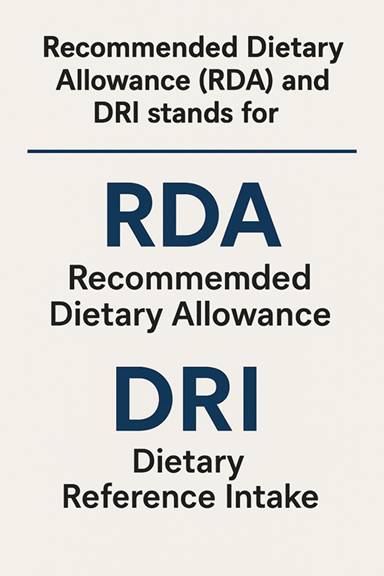Introduction
Have you ever wondered what does RDA stand for when reading nutrition labels? Seeing “% RDA” next to vitamins or minerals can be confusing if you’re not familiar with the term. Understanding what RDA stands for is essential not only for dietitians but also for anyone aiming to live a balanced and healthier life. In this guide, we’ll explain what RDA means, how it fits into broader dietary standards like the DRI, and why it’s important in both nutrition and dentistry.

What Does RDA Stand For?
In nutritional science, RDA sets the target intake for essential nutrients such as vitamins and minerals. It’s an important benchmark used by healthcare professionals, dietitians, and regulatory bodies.
Key points about RDA in nutrition:
- Purpose: To prevent nutritional deficiencies and optimize health.
- Foundation: Based on extensive research and recommendations by experts under the Food and Nutrition Board (FNB) of the National Academies.
- Application: Used in nutrition labeling, dietary planning, and public health policy.
Example RDAs:
- Calcium: 1,000 mg/day for adults.
- Vitamin C: 90 mg/day for men, 75 mg/day for women.
Resource: NIH: Healthy Eating Plan
What Is an RDA in Dentistry?
In the field of dentistry, RDA refers to a Registered Dental Assistant. While the abbreviation is the same, the meaning is entirely different:
- Role: Assist dentists in procedures, manage patient care, and maintain hygiene standards.
- Certification: RDAs are certified professionals, typically after completing a formal education program and passing a state or national exam.
Note: Always check the context to understand whether RDA refers to dietary recommendations or dental certifications.
Understanding DRI and Its Importance
Dietary Reference Intakes (DRI) is an umbrella term encompassing multiple nutrient reference values developed by the Food and Nutrition Board:

DRIs serve as a valuable tool for:
- Health professionals in planning diets.
- Policymakers in crafting nutrition-related policies.
- Consumers seeking balanced diets.
Define the Terms: Adequate Intake and Tolerable Upper Intake Level
Adequate Intake (AI)
AI is set when there isn’t sufficient evidence to establish an RDA. It’s based on observed nutrient intakes of healthy people and is considered a safe recommendation.
Example: AI for Vitamin K is set at 120 mcg for men.
Tolerable Upper Intake Level (UL)
UL is the highest level of daily nutrient intake that is likely to pose no risk of adverse health effects to almost all individuals in the general population.
Example: UL for Vitamin D is 4,000 IU per day for adults.
Resource: NATIONAL ACADEMIES: DRI
Daily Nutritional Requirements Chart
A simplified guide to recommended daily intakes for some essential nutrients:

Trustworthy Resources for RDA and DRI
Given the volume of nutrition information available online, it’s crucial to rely on verified sources. Here are some trustworthy resources:
- National Institutes of Health (NIH) – Office of Dietary Supplements
- Offers science-backed facts on vitamins, minerals, and dietary supplements.
- Website: ods.od.nih.gov
- U.S. Department of Agriculture (USDA) – Dietary Guidelines for Americans
- Provides updated RDA and DRI values alongside broader dietary recommendations.
- Website: www.dietaryguidelines.gov
- Food and Nutrition Board (FNB) – Institute of Medicine
- Main organization responsible for establishing DRIs.
- Website: www.nationalacademies.org
- World Health Organization (WHO) – Nutrition Guidelines
- Sets global nutrient intake standards and dietary recommendations.
- Website: www.who.int/nutrition
These institutions base their recommendations on rigorous clinical studies and expert consensus.
RDA is the daily amount of a nutrient that most healthy people should consume to maintain good health.
Regularly exceeding the UL can lead to nutrient toxicity and adverse health effects.
No. RDA values vary depending on age, gender, and life stages like pregnancy or lactation.
RDA is a specific value within the broader DRI system, which also includes AI, UL, and EAR.
Conclusion
Understanding RDA is essential for anyone interested in maintaining a balanced diet. Whether learning the basics of RDA in nutrition or differentiating it from its dental context, this knowledge empowers better health choices. When seeking dietary guidelines, remember to rely on authoritative sources like the NIH, USDA, and WHO.
You’re taking vital steps toward long-term wellness by staying informed and mindful of your nutrient intake!
Now that you understand RDA, apply it by [reading nutrition labels effectively] and verifying supplement dosages.